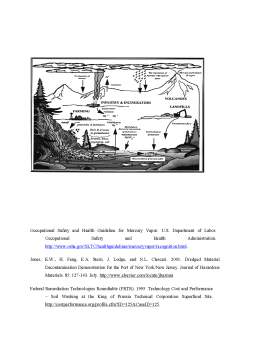Extras din proiect
SOLIDIFICATION AND STABILIZATION (INCLUDING AMALGAMATION)
Among the projects identified, solidification/stabilization (S/S) is the most frequently used technology to treat soil and waste contaminated with mercury. The data show that this technology has been used to meet regulatory cleanup levels, is commercially available to treat both soil and waste, and generates a residual that typically does not require further treatment before disposal. However, the data sources used for this report did not contain any information about the long-term stability of mercury-containing soil and waste treated using S/S.
Technologies for Soil Treatment
Solidification/ Stabilization Is the most frequently used technology for soil contamination in the projects identified. The data show that this technology has been used to meet regulatory cleanup levels, is commercially available to treat soil, and generates a residual that typically does not require further treatment prior to disposal. Other technologies for soil are typically used for specific soil types.
Soil Washing/ Acid Extraction Uses the principle that some contaminants preferentially adsorb onto the fines fraction of soil. The soil is suspended in a wash solution and the fines are separated from the suspension, thereby reducing the contaminant concentrations in the remaining soil. Acid extraction uses an extracting chemical, such as hydrochloric acid or sulfuric acid.
Thermal Desorption/ Retorting Application of heat and reduced pressure to volatilize mercury from the contaminated medium, followed by conversion of the mercury vapors into liquid elemental mercury by condensation. Off-gases may require further treatment through additional air pollution control devices such as carbon units.
Vitrification High-temperature treatment that reduces the mobility of metals by incorporating them into a chemically durable, leach-resistant, vitreous mass. The process also may cause contaminants to volatilize, thereby reducing their concentration in the soil.
Detection and site characterization of mercury using field-based analytical methods allows for ease of on-site application and quicker decision-making. The technologies are portable and provide continuous, real-time data. Some methods can be used outdoors with hand-held equipment; other, more rigorous methods require the controlled environments of a mobile laboratory.
Solidification and stabilization (S/S) is used to treat elemental mercury and mercury-contaminated soil and sludge. This technology has been implemented at full scale and pilot scale. S/S reduces the mobility of contaminants in the media by physically binding them within a stabilized mass or inducing chemical reactions. Amalgamation, the dissolution of mercury in other metals and solidification to form a non-liquid, semi-solid alloy called an amalgam, is often used for elemental mercury.
Technology Description and Principles
S/S is a process that has been used at full scale to treat mercury-contaminated soil. Many pilot- and bench-scale studies also have been conducted to identify binders and reagents that are more effective than conventionally used methods such as cement. S/S involves physically binding or enclosing contaminants within a stabilized mass (solidification) or inducing chemical reactions between the stabilizing agent and the contaminants to reduce their mobility (stabilization).
The stabilization process involves mixing soil with binders such as Portland cement, sulfur polymer cement (SPC), sulfide and phosphate binders, cement kiln dust, polyester resins, or polysiloxane compounds to create a slurry, paste, or other semi-liquid state, which is allowed time to cure into a solid form. For ex situ S/S processes that involve polyester resins, the resin and the soil are mixed at a low rate for 5 to 10 minutes until a homogeneous mixture is formed. A catalyst is then added to this mixture to initiate a polymerization reaction and mixing continues at a high rate for another 2 to 5 minutes until a rise in temperature signals the inception of curing. After that is allowed to cool down to harden (Ref. 3.16). EPA has identified amalgamation as the best demonstrated available technology (BDAT) for treatment of liquid elemental mercury contaminated with radioactive materials (Ref. 3.3). Amalgamation is the dissolution and solidification of mercury in other metals such as copper, nickel, zinc and tin, resulting in a solid, nonvolatile product. It is a subset of solidification technologies, and it does not involve a chemical reaction. The S/S process may also include addition of pH adjustment agents, phosphates, or sulfur reagents to reduce the setting or curing time, increase the compressive strength, or reduce the leachability of contaminants.
Preview document
Conținut arhivă zip
- Soil and Waste Treatment Technologies.docx



















